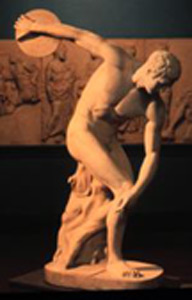Plaster Cast: The Discobolos after Myron, Discus Thrower
1912.02.0002
Detailed Images
Basic Information
| Artifact Identification | Plaster Cast: The Discobolos after Myron, Discus Thrower (1912.02.0002) |
|---|---|
| Classification/ Nomenclature |
|
| Artist/Maker | Original sculptor: Myron of Eleutherae (a village bordering Attica and Boeotia in Greece) |
| Geographic Location | |
| Period | Classical Period |
| Date | 450 BCE |
| Culture | Greek |
| Location | On Exhibitin the Ancient Mediterranean exhibit |
Physical Analysis
| Dimension 1 (Height) | 172.8 cm |
|---|---|
| Dimension 2 (Width) | 104.0 cm |
| Dimension 3 (Depth) | 49.8 cm |
| Weight | waived g |
| Measuring Remarks | Under Review |
| Materials | Plaster |
| Manufacturing Processes | Cast |
Research Remarks
| Description | N/A |
|---|---|
| Published Description | Under Review |
| Bibliography | "Archeological Museum is Opened in Lincoln Hall," 1912P.0002. |
Artifact History
| Credit Line/Dedication | Classical Museum Purchase |
|---|---|
| Reproduction | yes, Original made at Elutherae, Greece. Plaster reproduction of Roman marble copy of Greek bronze original found in Rome in 1761 near the ruins of the castellum or reservoir of the Aqua Julia built by Septimius Severus now in the Vatican, manufactured by P. P. Caproni & Brother, Boston, 1912. |
Contact
All information about our collection is constantly reviewed and updated. Please contact Dery Martínez-Bonilla, Registrar, if there is any information you are looking for that isn't currently online.
